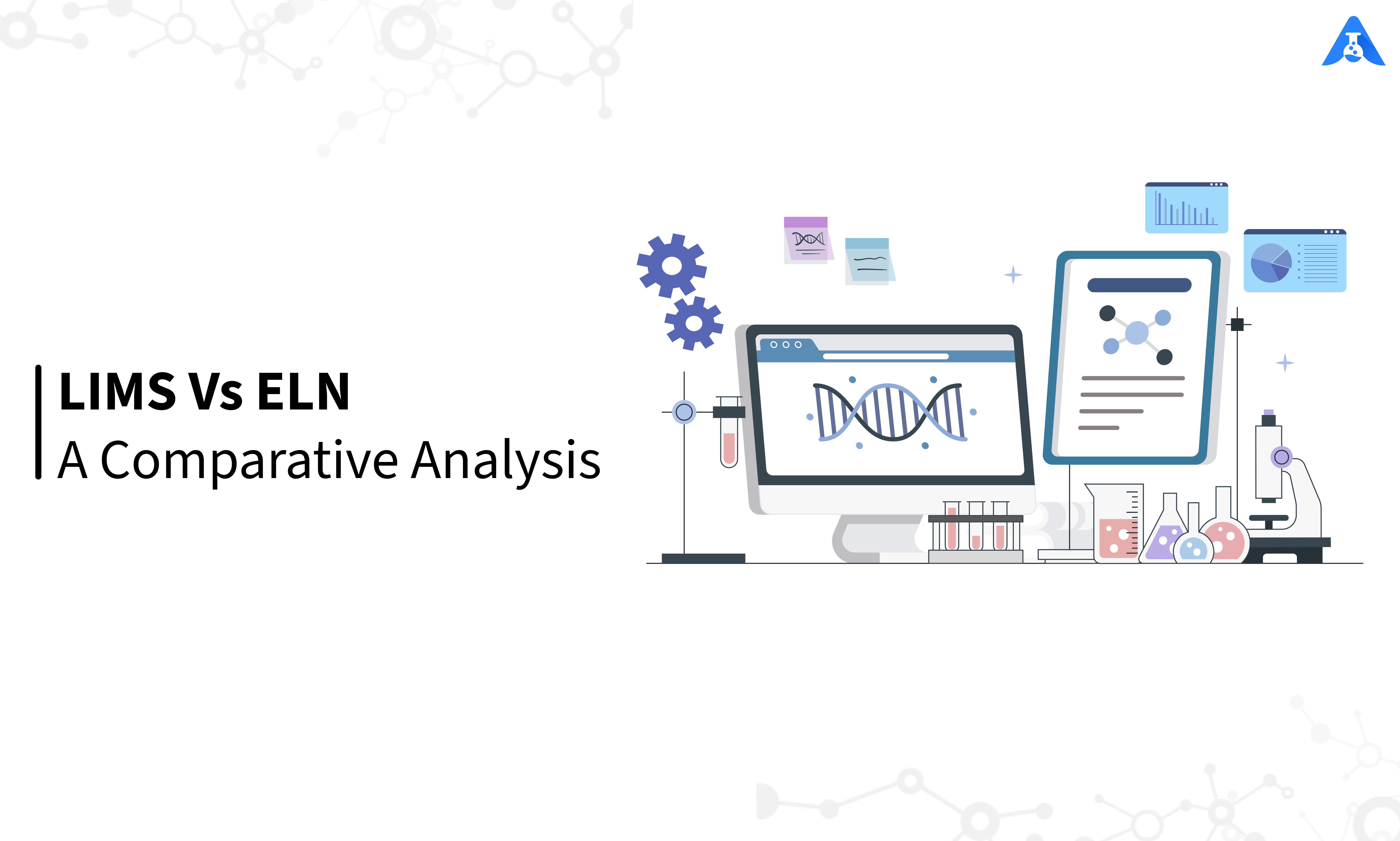Modern problems require modern solutions.
In the ever-changing world, it is imperative to adapt to the modern world’s demands, especially in the field of science and technology.
Digital lab informatics solutions are fast becoming a necessity in laboratories to streamline data and elevate lab operations.
However, due to the sheer number of lab software products available in the market, researchers and scientists are often confused about the best option for their requirements.
Let’s look into two of the most used applications in modern scientific research and industry laboratories — Laboratory Information Management Systems (LIMS) and Electronic Laboratory Notebooks (ELN).
They serve complementary but distinct functions.
Let us compare and explore their key differences across various dimensions to find out the right option for your labs.

Definition

LIMS: A Laboratory Information Management System is a software-based solution that supports laboratory operations by managing samples, laboratory users, instruments, standards, and other laboratory functions such as workflows, reporting, and data tracking.
ELN: An Electronic Laboratory Notebook is a digital version of a paper lab notebook. It is used for the electronic storage of experiments, procedures, and results, enabling researchers to document research, experiments, and procedures performed in a lab.
Usage and Application Areas
Laboratory Information Management Systems (LIMS) is primarily used in analytical laboratories, quality control labs, manufacturing, and regulatory environments where managing samples, compliance, and workflow efficiency are critical. It is widely adopted in industries like pharmaceuticals, biotechnology, environmental testing, food and beverage, and petrochemicals.
Electronic Laboratory Notebooks (ELN) finds its use in research and development settings, including academic, government, and industrial research labs. It is used for documenting research hypotheses, experimental procedures, results, and observations.
Primary Users
Laboratory Information Management Systems (LIMS)
Quality Control Laboratories: Industries like pharmaceuticals, food and beverage, and manufacturing rely heavily on LIMS for quality control, ensuring their products meet the required standards and regulations.
Research and Development (R&D) Laboratories: R&D labs across various sectors, including biotechnology, chemicals, and consumer goods, use LIMS to track experiments, manage samples, and maintain compliance with regulatory requirements.
Clinical and Healthcare Laboratories: Hospitals, diagnostic centers, and clinical research organizations utilize LIMS for managing patient samples, tracking test results, and ensuring compliance with healthcare regulations like HIPAA in the United States.
Environmental Testing Laboratories: These labs use LIMS to monitor environmental samples (water, air, soil) and manage large datasets, ensuring compliance with environmental regulations.
Government and Regulatory Bodies: LIMS is used for monitoring compliance with regulations, managing data for public health initiatives, and conducting forensic analyses.
Electronic Lab Notebooks (ELN)
Academic Research Laboratories: Researchers and students across various scientific disciplines use ELNs to digitally record their experiments, findings, and protocols, promoting collaboration and data sharing.
Pharmaceutical and Biotech Companies: In R&D and drug discovery, ELNs are crucial for documenting hypotheses, experimental procedures, results, and observations, facilitating intellectual property protection and regulatory compliance.
Chemical Industries: Chemists and material scientists use ELNs for documenting formulae, experiment results, and safety procedures, thus enhancing research productivity and innovation.
Clinical Research Organizations (CROs): CROs utilize ELNs for clinical trials, documenting protocols, patient data, and results to ensure data integrity and compliance with regulatory standards.
Government Research Institutions: ELNs support government-funded research projects, enabling data integrity, secure sharing of sensitive information, and collaboration among scientists.
Overlapping Users
Pharmaceutical and Biotech Companies: Both sectors leverage LIMS for quality control and ELN for R&D documentation.
Academic and Government Research Labs: These entities use ELNs for academic purposes and LIMS for managing samples and compliance-related documentation.
Clinical and Healthcare Laboratories: They utilize LIMS for sample and data management while adopting ELNs for research and development documentation within the healthcare sector.
General Similarities and Differences
Flexibility & Customizability
Laboratory Information Management Systems (LIMS)
Flexibility: LIMS is highly flexible in terms of operational scope. They are designed to adapt to a wide range of laboratory workflows, from sample tracking to quality control and regulatory compliance. This flexibility is crucial for laboratories that deal with a high volume of samples and complex testing protocols.
Customizability: LIMS platforms often offer significant customizability to meet the specific needs of different laboratories. This can include custom workflow designs, specific data fields for sample tracking, and reporting formats. However, the extent of customizability can vary significantly between different LIMS providers, and extensive customization might require dedicated IT support or the services of the LIMS vendor, potentially increasing costs, and implementation time.
Electronic Lab Notebooks (ELN)
Flexibility: ELNs are inherently flexible in terms of data entry, supporting a wide range of content types including text, images, charts, and even direct data feeds from laboratory instruments. This flexibility is essential for supporting the diverse documentation needs of researchers and scientists across different fields.
Customizability: ELNs offer a high degree of customizability in terms of the organization and presentation of data. Users can often customize templates, data structures, and integration with other software (e.g., data analysis tools or LIMS), allowing for a personalized approach to data logging and reporting. The level of customizability can vary, with some platforms offering more user-friendly interfaces for customization than others.
Comparative Analysis
Scope of Customization: LIMS customization often focuses on workflow efficiency, data management, and compliance, while ELN customization is more about enhancing research documentation, collaboration, and data analysis.
User Interface: ELNs generally offer a more user-friendly interface for customization to accommodate the diverse needs of researchers without requiring extensive IT knowledge. In contrast, LIMS customization may require more specialized knowledge or vendor assistance.
Flexibility in Application: Both systems are flexible but cater to different aspects of laboratory operations; LIMS are more focused on sample management and operational workflows, whereas ELNs focus on the flexibility of data recording and research collaboration.
User Experience & User Interface
The user experience (UX) and user interface (UI) of Laboratory Information Management Systems (LIMS) and Electronic Lab Notebooks (ELN) significantly influence their adoption and effectiveness in laboratory settings. Both systems are designed to meet the needs of their users, but they do so in different ways, reflecting their distinct purposes.
Laboratory Information Management Systems (LIMS)
User Experience: LIMS are designed to streamline laboratory operations, focusing on efficiency, accuracy, and compliance. The user experience is often oriented towards functionality that supports sample management, workflow automation, and regulatory compliance. Users might find LIMS interfaces to be highly structured, reflecting the systematic nature of the tasks they are designed to manage.
User Interface: The UI of LIMS can be complex due to the extensive functionalities they offer, including sample tracking, data management, reporting, and integration with other laboratory instruments and systems. This complexity can sometimes result in a steep learning curve for new users. However, modern LIMS are increasingly incorporating more intuitive design elements to improve ease of use.
Electronic Lab Notebooks (ELN)
User Experience: ELNs focus on enhancing the documentation and collaboration aspects of laboratory work. The user experience is tailored towards simplicity and ease of data entry, with features such as drag-and-drop, templating, and multimedia support. ELNs aim to replicate the flexibility and familiarity of paper notebooks while offering the advantages of digital organization, searchability, and data sharing.
User Interface: The UI of ELNs tends to be more user-friendly and visually appealing compared to traditional LIMS. This is because ELNs are designed for a broad user base, including researchers and scientists who may not have extensive technical training. The emphasis is on making data entry as straightforward as possible, with intuitive navigation and the ability to easily organize and retrieve information.
Comparative Analysis:
Complexity vs. Simplicity: LIMS often have a more complex UI and UX due to the technical and regulatory requirements they must fulfill, while ELNs prioritize simplicity and ease of use to accommodate the daily documentation needs of researchers.
Focus on Functionality vs. Usability: LIMS interfaces are designed with an emphasis on functional requirements and integration capabilities, which can sometimes compromise user-friendliness. In contrast, ELNs focus on usability, aiming to make digital documentation as intuitive as writing in a traditional lab notebook.
Learning Curve: The learning curve for LIMS can be steeper than for ELNs, reflecting the complexity of the tasks they manage. ELNs, with their focus on user-friendly documentation, tend to be easier for new users to adopt.
Features Comparison
Laboratory Information Management Systems (LIMS) features include
- Sample Management
- Workflow Automation
- Quality Control
- Compliance Management
- Competence Management
- User Management & Security
- Inventory Management
- Reporting
- Audit Trail
- Electronic Signatures
Electronic Laboratory Notebooks (ELN) features include
- Digital Note-Taking
- User Management & Security
- Collaboration Tools
- Template Management
- Protocol Management
- Data Integration from Experiments
- Electronic Signatures
- Audit Trail Timestamps for IP protection
The following is the comparison of features between LIMS and ELN:
Sample Management
LIMS: Excelling in sample management, LIMS track samples from reception through testing to disposal, managing metadata, storage locations, and chain of custody.
ELN: Focuses less on physical sample management and more on documenting experiments and observations related to samples.
Data Management
LIMS: Designed for robust data management, including structured data related to samples, testing protocols, and results.
ELN: Manages unstructured or semi-structured data such as notes, hypotheses, and experimental results, often in free-form text or multimedia formats.
Workflow Automation
LIMS: Highly effective in automating laboratory workflows, including sample processing, task assignments, and quality control processes.
ELN: Supports workflow automation by enabling templating and standardization of experimental records, but less focused on laboratory operational workflows.
Integration with Instruments
LIMS: Strong capabilities for integrating with laboratory instruments and equipment for automated data capture and processing.
ELN: Some ELNs offer integration with lab instruments, primarily for direct data entry into experimental records, but this is not as comprehensive as in LIMS.
Regulatory Compliance
LIMS: Tailored to ensure compliance with industry-specific regulations, capable of generating audit trails, managing SOPs, and ensuring data integrity.
ELN: Supports compliance through secure, timestamped records and digital signatures, but with a focus on documenting the research process rather than compliance management.
Quality Control
LIMS: Central to quality control processes, LIMS manage QC protocols, track QC samples, and ensure adherence to standards.
ELN: Indirectly contributes to quality control by documenting experimental procedures and results, which can be referenced for QC purposes but does not manage QC processes directly.
User Management and Security
LIMS: Typically offers comprehensive user management and security features, controlling access based on roles and responsibilities, ensuring data security and integrity.
ELN: Also provides user management and security capabilities, with a focus on protecting intellectual property and ensuring authorized access to experimental records.
Inventory Management
LIMS: Often includes inventory management features for tracking reagents, consumables, and equipment, including expiration dates and re-order levels.
ELN: Generally, does not include inventory management as a core feature, focusing instead on the experimental use of these items rather than their tracking and replenishment.
Reporting
LIMS: Strong reporting capabilities, generating standardized reports for management, regulatory submissions, and operational efficiency.
ELN: Offers flexible reporting primarily focused on research outcomes and experimental data, with customizable templates for presenting findings.
Audit Trail
LIMS: Provides detailed audit trails for all sample-related actions, essential for regulatory compliance and traceability.
ELN: Maintains audit trails for the creation, modification, and deletion of records, supporting research integrity and compliance.
Digital Note-Taking
LIMS: Not typically designed for free-form note-taking; focuses on structured data entry.
ELN: Excelling in digital note-taking, ELNs offer flexible formats for recording observations, insights, and detailed experimental narratives.
Collaboration Tools
LIMS: Collaboration is more operational, facilitating communication and task management within laboratory workflows.
ELN: Provides strong collaboration tools, including shared access to projects, real-time editing, and communication features, fostering teamwork and idea sharing across research projects.
Scalability & its Future Trends
Laboratory Information Management System (LIMS):
Scalability: LIMS are designed to scale efficiently with the growth of a laboratory’s operations, handling increased data volumes, more complex workflows, and a greater number of users. The architecture of LIMS often allows for modular expansion, enabling labs to add functionalities such as additional sample processing capabilities or integrations with new instruments as their needs evolve.
Future Trends: The scalability of LIMS will likely focus on enhancing interoperability with a broader ecosystem of laboratory and enterprise applications, facilitating seamless data flow across platforms, and supporting the integration of advanced analytics and artificial intelligence (AI) to predict trends and optimize laboratory operations.
Electronic Lab Notebook (ELN):
Scalability: ELNs also offer scalability, but with a focus on accommodating growing amounts of research data, expanding teams, and diversifying project types. They are designed to support more users and projects, enabling researchers to efficiently organize and access large volumes of experimental data.
Future Trends: For ELNs, future scalability trends are expected to emphasize further enhancements in user experience, with more intuitive interfaces and advanced features for data visualization and analysis. Integration with LIMS and other data sources will become more streamlined, and the use of cloud-based platforms will facilitate collaboration across geographically dispersed teams. Additionally, ELNs will likely incorporate more AI-driven functionalities for data mining and predictive analytics to aid in research and development efforts.
Future Trends in Laboratory Data Management
Integration and Interoperability: Both LIMS and ELNs are moving towards greater integration not only with each other but also with a wide range of laboratory instruments, enterprise systems, and third-party applications. This trend is driven by the need for holistic data management strategies that encompass the entire lifecycle of laboratory information.
Cloud-based Solutions: The shift towards cloud-based platforms is a significant trend for both LIMS and ELNs, offering scalability, flexibility, and enhanced collaboration capabilities. Cloud solutions facilitate remote access to data and tools, an essential feature in today’s increasingly decentralized research environments.
AI and Machine Learning: The incorporation of AI and machine learning technologies is a growing trend, with LIMS using these technologies to optimize operational workflows and predictive maintenance of instruments. ELNs are leveraging AI to enhance data analysis, automate data entry, and provide insights from vast datasets, revolutionizing the way research is conducted and accelerating discovery processes.
Choosing between LIMS or ELN for your lab
Choosing between a Laboratory Information Management System (LIMS) and an Electronic Lab Notebook (ELN) depends on the specific needs, workflows, and goals of a laboratory. Here are some key considerations for decision-makers to help pick the right application:
- Identify Your Primary Needs
- Evaluate Workflow and Data Management Requirements
- Consider Regulatory Compliance and Quality Control Needs
- Look at Integration Capabilities
- Assess Scalability
- Budget and Resource Considerations
- Review Security and User Management Features
- Conduct Vendor Assessments and Demos
- Solicit Feedback from End-Users
- Consider Future Trends
By carefully considering these guidelines, decision-makers can select the right application that aligns with their lab’s specific needs, promotes efficiency, and supports future growth.
Conclusion
In the ever-evolving landscape of laboratory management, the decision between adopting a Laboratory Information Management System (LIMS) or an Electronic Lab Notebook (ELN) is pivotal. As we have navigated through the intricacies of LIMS and ELN, it’s evident that while both systems offer distinct advantages, their effectiveness ultimately hinges on the specific needs, workflows, and objectives of a laboratory.
LIMS excels in streamlining operations, enhancing sample traceability, ensuring regulatory compliance, and automating workflows, making it indispensable for labs focusing on quality control and high-volume sample management. On the other hand, ELN stands out in facilitating research documentation, fostering collaboration, and enhancing data sharing and management, proving invaluable for environments where innovation, research, and development are at the forefront.
The choice between LIMS and ELN is not just a matter of preference but a strategic decision that can significantly impact a lab’s operational efficiency, compliance posture, and research capabilities. For labs at the crossroads of this decision, the key lies in a thorough assessment of their operational requirements, future growth aspirations, and the regulatory landscape they navigate.
Embracing either system—or in some cases, integrating both—offers a pathway to enhanced data integrity, improved operational efficiencies, and a robust foundation for scientific discovery. As laboratories continue to adapt to the digital age, the importance of selecting the right management system becomes ever more critical. Whether it’s LIMS with its operational prowess or ELN with its emphasis on collaboration and innovation, the ultimate goal remains the same: to propel the laboratory forward in an era of rapid technological advancement and increasing scientific complexities.
In conclusion, as we look towards the future of laboratory management, the decision between LIMS and ELN represents more than just a choice of software—it symbolizes a commitment to excellence, efficiency, and the relentless pursuit of scientific innovation. By carefully considering their unique needs, laboratories can select a system that not only meets their current demands but also paves the way for future successes in the dynamic and exciting field of scientific research.





